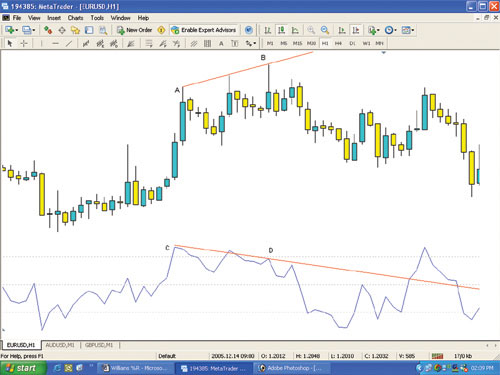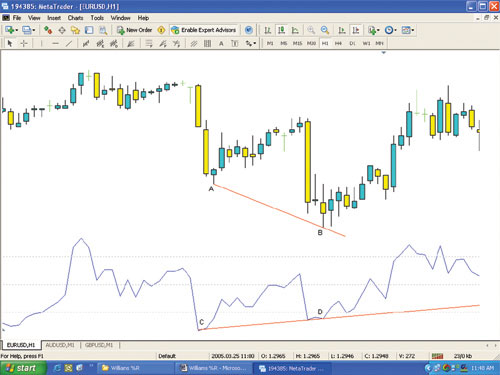Oscillators: Williams Percent Range (%R)
The values of the Williams Percent Range (%R) oscillator lie between 0 and 100.
If the oscillator is between 80% to 100%, it denotes an oversold condition, whereas values in the range from 0% to 20% signify an overbought condition.
The formula to calculate Williams Percent Range oscillator is similar to the one used to calculate the Stochastic Oscillator:
%R = (MAX (HIGH (i - n)) - CLOSE (i)) / (MAX (HIGH (i - n)) - MIN (LOW (i - n))) * 100
Where:
- CLOSE (i) - the current close price;
- MAX (HIGH (i - n)) - the highest top over the previous n periods;
- MIN (LOW (i - n)) - the lowest bottom over the previous n periods.
Williams Percent Range (%R) oscillator signals:
- bullish divergence / bearish convergence the main signals that point to the weakness of the current trend;
- in a flat market an exit from the overbought / oversold area is a signal to sell / buy.
To add Williams Percent Range index in MetaTrader 4 use the "Insert -> Indicators -> Oscillators -> Williams Percent Range, %R" menu sequence.
Williams Percent Range index:

Williams Percent Range index
Market Psychology
Each price is a consensus of value among traders. The recent high range shows the bulls or buyers maximum power. The low of the recent range reflects the maximum power of the bears during that trading range. The most important consensus is as always the closing price.
Williams %R compares each closing price to the recent range indicating whether bulls can close the price near the top of the range, or bears can close the market at the bottom of the price.
Price may be pushed higher or lower during the day but the Williams %R will indicate which group is actually capable of closing the market.
If bulls cannot close the market near the top of a rally they are weaker than they seem and this creates a shorting opportunity. If bears cannot close the market near the lows during a decline then they are weaker than they appear and this creates a buying opportunity.
Trading Rules
Divergences between price and Williams %R rarely occur, when they do these divergences identify the best trading opportunities using Williams %R.
Below is a 1hr price chart of the EUR/USD with Williams %R set at 14 showing bearish divergence:

The A-B line indicates the price advancing and the C-D line indicates the Williams %R nudging downwards showing bearish divergence. You would look for opportunities to short the market when bearish divergence occurs on the Williams %R.
Below is a 1hr price chart of the EUR/USD with Williams %R set at 14 showing bullish divergence:

The A-B line indicates price declining and the C-D line indicates the Williams %R nudging upwards showing bullish divergence. You would look for opportunities to go long the market when bullish divergence occurs on the Williams %R.
There are also less significant ways to trade Williams %R but this method is oneof the most poular. The second way to use Williams %R is to identify overbought and oversold conditions.
More on the Williams %R
It is important to remember that overbought does not necessarily imply time to sell, and oversold does not necessarily imply time to buy. A security can be in a downtrend, become oversold and remain oversold as the price continues to trend lower. Once a security becomes overbought or oversold, traders should wait for a signal that a price reversal has occurred.
As always, price reversal confirmation can also be accomplished by using other indicators or aspects of technical analysis with Williams %R.
One method of using Williams %R might be to identify the underlying trend and then look for trading opportunities in the direction of the trend. In an uptrend, traders may look to oversold readings to establish long positions. In a downtrend, traders may look to overbought readings to establish short positions.
How to Trade
The trading rules are simple. You sell when %R reaches 20% or lower (the market is overbought) and buy when it reaches 80% or higher (the market is oversold). However, as with all overbought/oversold indicators, it is wise to wait for the indicator price to change direction before initiating any trade.
Larry Williams defines the following trading rules for his %R: Buy when %R reaches 100%, and five trading days have passed since 100% was last reached, and after which the %R again falls below 85/95%. Sell when %R reaches 0%, and five trading days have passed since 0% was last reached, and after which the Williams %R again rises to about 15/5%.
No comments:
Post a Comment